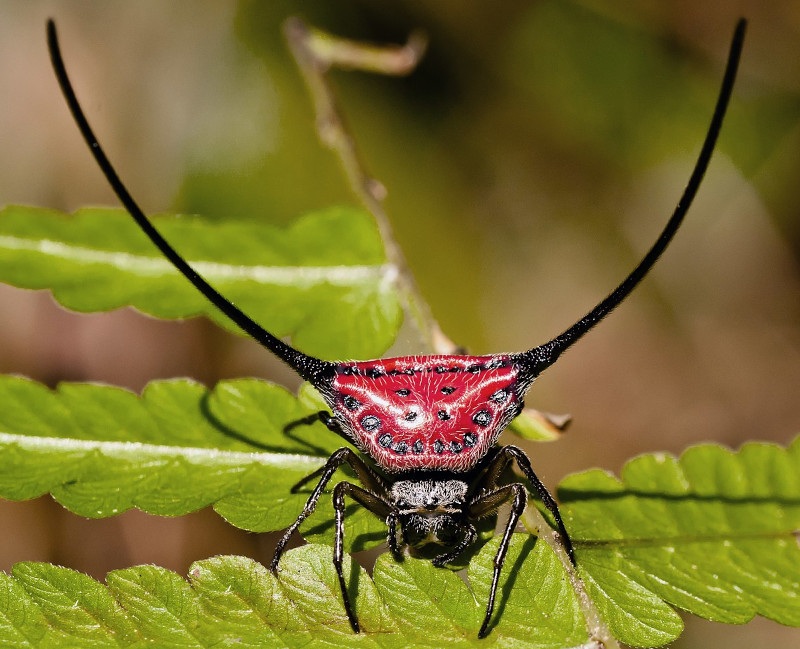Long-Horned Orb Weaver Facts
- This incredible arachnid most frequently goes by the appropriate and descriptive common name of the Long-Horned Orb Weaver. The invertebrate does have one other alternate name, however. That’s the equally apt term of the Curved Spiny Spider.
- Meanwhile, professionals, such as researchers, more typically use its formal scientific name to refer to it. That, though, is the somewhat hard to pronounce technical name of the Macracantha arcuata. Whichever name one uses, it’s a remarkable species.
- The visually impressive creation of evolution received its formal name at the hands of the renowned Danish zoologist, Johan Christian Fabricius. He made the first formal acknowledgement of the insect as a separate and distinct species, in the year 1793.
- It stands out from the many other related creatures around the globe in an uncommon way. That’s in its uniqueness. That’s because, for the moment, this species constitutes the only known member of its genus. Further research may change that, however.
- Currently, the Long-Horned Orb Weaver appears to be maintaining a population base that’s both sizeable and stable. This further seems to hold true throughout the entirety of its range. The IUCN, therefore, presently has no listing for it on its Red List.
- This marvel of Nature nevertheless must be considered to be facing several threats to its continued existence. Habitat loss forms an ever-present danger, due to man’s expansion, of course. Its greatest threat, though, likely consists of climate change.
Related Articles
Long-Horned Orb Weaver Physical Description
The magnificent, not to mention distinctive, Long-Horned Orb Weaver easily impresses those fortunate enough to view it. The invertebrate does not, however do so due to sheer physical size. That’s because it’s actually quite tiny, especially compared to some others.
Much like many arachnids, though, it also displays the physiological characteristic of sexual dimorphism. In its specific case, this trait manifests itself in terms of pure physical size. That trait further results in a rather extreme difference in the sizes of the genders.
Among the females, body lengths average 0.8 – 1.0 in (2.0 – 2.6 cm). This measurement, however, narrows to about 0.31 – 0.35 in (0.8 – 0.9 cm) at the waist. The males, meanwhile, only reach a fraction of this size. They measure about (0.15 cm) at the waist.
The body also displays different color patterns between the upper and lower surfaces. The upper surface of the body ranges in color from red, to yellow, to white, or even black. It also displays black spots. The underside of the body, though, shows yellow or orange.
Yet the amazing Long-Horned Orb Weaver stands out for one more reason. That’s the long horn-like structures, displayed only by the females. That’s yet another form of gender-based difference it manifests. These reach many times the length of the body of the arachnid.
- Kingdom: Animalia
- Phylum: Arthropoda
- Class: Arachnida
- Order: Araneae
- Family: Araneidae
- Genus: Macracantha
- Species: M. arcuata
Long-Horned Orb Weaver Distribution, Habitat, and Ecology
Luckily, both for the Long-Horned Orb Weaver itself, and those who appreciate the wonders of Nature, it evolved as native a relatively broad swathe of the globe. That holds true due to the fact that the intriguing Arthropod evolved as native to a large part of Asia.
More precisely, evidence indicates that it developed as endemic to the southern and southeastern portions of the large continent. There, it makes appearances from the countries of India and China in the south, and all the way to Borneo in the southeast portion.
In every region in which it appears, however, it displays decidedly strong preferences in its choice of habitat. The remarkable spider makes its home in regions of either temperate or tropical forest. The majority of specimens seem to live in areas of tropical rainforest.
The females of the species typically construct their nests between the branches of various trees. These they further design with an average width of between 3 – 4 ft (1.0 – 1.2 m). The webs also generally have hollow hubs and white silk beads on their radial threads.
Unlike some spiders, though, the female Long-Horned Orb Weaver rarely sits in her web to await her prey. Instead, she typically waits beneath leaves located nearby. Like most spiders, this species feeds opportunistically, on any species it successfully traps in its web.
From this vantage point the arachnid can wait for its victim, and remain safe from its own predators. These mainly include various types of local birds. The venom of this species, though lethal to smaller creatures, generally poses no known serious threat to humans.
Species Sharing Its Range
Check out our other articles on 3 Particularly Precious Parrots, Lake Baikal, Indo-Pacific humpback dolphin, Hemlock Looper, Saltwater Crocodile, Tree Heather, Wood Frog, Pesquet’s Parrot

